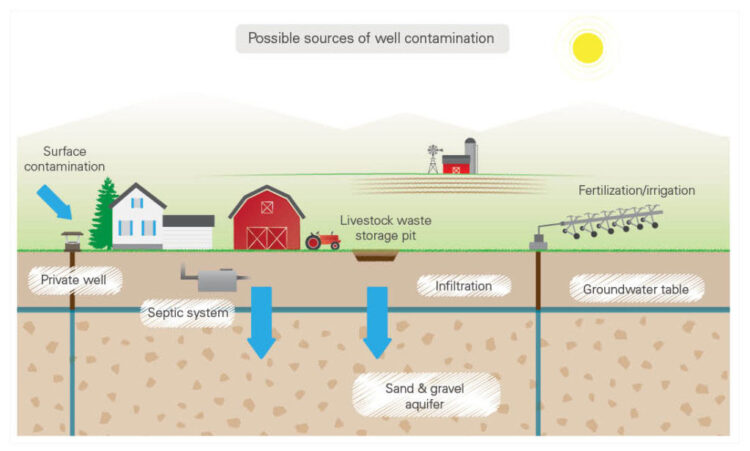Well Water Quality
Homeowners using a private well or one shared with a few neighbors are responsible for the quality of the water they are consuming. Understanding how well water may become contaminated with natural or manmade contaminants is key to avoiding possible illness and managing aesthetic water issues.
There are multiple ways that well water contamination can happen. Heavy rainfall, spring runoff, and flood events can overwhelm even well-constructed, recently drilled wells, introducing surface contaminants into the aquifer below. If the well is older, the risk of surface contamination infiltrating the well is even greater.

Potential Well Water Contamination Issues:
- Sources of contamination, like a septic system, that are too close to the well
- A dug well that’s lined with poorly sealed brick, stone, or tile or has unsealed covers
- An improperly sealed casing through a bedrock formation or other unconsolidated formation, which can allow contaminated water to migrate into the aquifer
- A well casing that doesn’t extend far enough above the ground surface
- A well casing that ends in a basement, pit, or another area prone to flooding or seepage
- Corroded well casings that allow water to seep into the well from holes or cracks
- A well casing with a non-complying depth that enables contaminated near-surface water to enter a well
- Substandard, old stove-pipe casings that allow near-surface water to infiltrate the well
- Poorly installed well cap that lets insects and small animals enter the well
Possible Microbes in Well Water
The most important thing to know about microbes in well water is that they cannot be seen, smelled, or tasted. Conducting a bacterial test with a certified laboratory is the only way to determine if the drinking water presents a risk.
According to the CDC, the common causes of disease outbreaks in wells are:
- Campylobacter (bacteria)
- Cryptosporidium (protozoa)
- E. coli (bacteria)
- Giardia (protozoa)
- Hepatitis A (virus)
- Salmonella (bacteria)
- Shigella (bacteria)
- Total coliforms
More than 20 percent of private domestic wells sampled nationwide contain at least one contaminant at levels of potential health concern, according to a study by the U.S. Geological Survey (USGS). The USGS also found bacteria, including total coliform and Escherichia coli, in as many as one-third of a subset of 400 wells.
Further Help and Resources
If you suspect any of these issues with your well, call a well drilling professional.
To learn more about taking care of your well and how to identify potential issues, visit the National Ground Water Association’s website, wellowner.org. It covers all the basic information pertaining to well ownership and stewardship and runs regular training classes about well care.
>> Next: Surface Water Contamination
